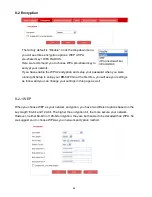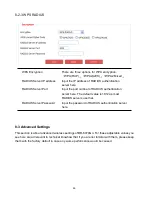
42
(a)2.4GHz(b+g+n): 802.11b + 802.11g +802.11n (default
setting)
(b) 2.4GHz(b): 802.11b
(c) 2.4GHz(g): 802.11g
(d) 2.4GHz(n): 802.11n
(e) 2.4GHz(b+g): 802.11b and 802.11g
ESSID
Broadcast ESSID
ESSID is the name of broadband router which is used to
identify your own broadband router from others in the same
area.
If you enable
“
Broadcast ESSID”, the router will be opened
to be searched and accessed by wireless adapters or devices.
If you disable “Broadcast ESSID”, this ESSID won’t be
searched, only those who know this ESSID can access it.
Channel Number
Select the channel number of frequency ranges. North
America uses channel 1~11. Europe uses channel 1~13.
Channel Width
There are 2 channel width: 20MHz and 40MHz
。
We
recommend you to choose
“
Auto 20/40MHz”.
Wireless Clients
Click ‘Show Active Clients’ button to show the list of all
connected wireless clients. You can click ‘Refresh’ in new
window to get the latest list again, or click ‘Close’ to close the
window.
Wireless Standard
(IEEE 802.11b/g/n)
:
Normally an indoor environment would adapt b+g+n and
「
Auto 20/40 MHz
」
. This is because
such settings can help data transmitting in short distance to be in higher speed. If you’d like to
use BR-6479Gn for longer distant data transmitting, you are recommended to apply 802.11b and
20MHz. This is because long distant transmission is difficult to meet high speed wireless transfer
rates at 150~300Mbps,
so for the sake of more sophisticated transmission quality, we recommend to manually reduce
the speed and bandwidth to achieve a more precise transmission quality.
Channel Number
:
Allowable channels, allowed users and maximum power levels within frequency ranges are
applied to countries accordingly. You may consult your local authorities. Here we add the
channel information for your reference. For further information, you may check Wikipedia.
















































